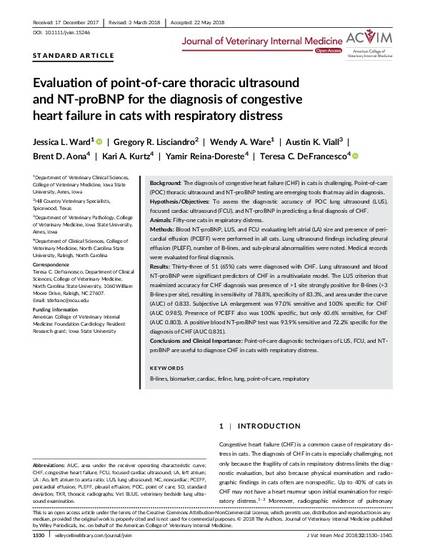
Background The diagnosis of congestive heart failure (CHF) in cats is challenging. Point‐of‐care (POC) thoracic ultrasound and NT‐proBNP testing are emerging tools that may aid in diagnosis.
Hypothesis/Objectives To assess the diagnostic accuracy of POC lung ultrasound (LUS), focused cardiac ultrasound (FCU), and NT‐proBNP in predicting a final diagnosis of CHF.
Animals Fifty‐one cats in respiratory distress.
Methods Blood NT‐proBNP, LUS, and FCU evaluating left atrial (LA) size and presence of pericardial effusion (PCEFF) were performed in all cats. Lung ultrasound findings including pleural effusion (PLEFF), number of B‐lines, and sub‐pleural abnormalities were noted. Medical records were evaluated for final diagnosis.
Results Thirty‐three of 51 (65%) cats were diagnosed with CHF. Lung ultrasound and blood NT‐proBNP were significant predictors of CHF in a multivariate model. The LUS criterion that maximized accuracy for CHF diagnosis was presence of >1 site strongly positive for B‐lines (>3 B‐lines per site), resulting in sensitivity of 78.8%, specificity of 83.3%, and area under the curve (AUC) of 0.833. Subjective LA enlargement was 97.0% sensitive and 100% specific for CHF (AUC 0.985). Presence of PCEFF also was 100% specific, but only 60.6% sensitive, for CHF (AUC 0.803). A positive blood NT‐proBNP test was 93.9% sensitive and 72.2% specific for the diagnosis of CHF (AUC 0.831).
Conclusions and Clinical Importance Point‐of‐care diagnostic techniques of LUS, FCU, and NT‐proBNP are useful to diagnose CHF in cats with respiratory distress.
Available at: http://works.bepress.com/jessica-ward/7/

This article is published as Ward, Jessica L., Gregory R. Lisciandro, Wendy A. Ware, Austin K. Viall, Brent D. Aona, Kari A. Kurtz, Yamir Reina‐Doreste, and Teresa C. DeFrancesco. "Evaluation of point‐of‐care thoracic ultrasound and NT‐proBNP for the diagnosis of congestive heart failure in cats with respiratory distress." Journal of Veterinary Internal Medicine 32, no. 5 (2018): 1530-1540. DOI: 10.1111/jvim.15246. Posted with permission.